1) Natural geography
|
Area > Comparative to US places
|
||
|
Capital city with population |
Malabo - 30,418 |
|
|
Forested Land |
62.5% |
[18th of 193] |
|
Geographic coordinates |
2 00 N, 10 00 E |
|
|
land border lengths > D-F > Number of neighbours |
2 |
[8th of 14] |
|
land border lengths > D-F > Total Borders |
539 km |
[10th of 14] |
|
Largest city population |
30,000 |
[161st of 174] |
|
Largest city with population |
Malabo - 30,418 |
|
|
northernmost point > Latitude |
03°47'N |
|
|
Population density |
16.6 people per sqkm |
[189th of 256] |
|
Population density > people per sq. km |
17.95 people/m² |
[165th of 204] |
|
Rural population density > rural population per sq. km of arable land |
226.28 people/km² of arable lan |
[102nd of 188] |
|
Surface area > sq. km |
28,050 km² |
[141st of 206] |
|
tallest mountains > Mountain |
Pico Basile |
|
SOURCES All
CIA World Factbooks
18 December 2003 to 18 December 2008; United Nations
World
Statistics Pocketbook
and
Statistical
Yearbook
, City Population
, CIA World
Factbook, World Gazetteer , Official government websites.; FAO; Wikipedia
List of land
border lengths
; United Nations
World
Statistics Pocketbook
and
Statistical
Yearbook ; Wikipedia
List of countries by northernmost point
;
Heal The World
Foundation.
; World
Development Indicators database ; Wikipedia
List
of tallest mountains by country
ALTERNATIVE NAMES Equatorial Guinea, Republic of Equatorial
Guinea, Republica de Guinea Ecuatorial, Guinea Ecuatorial
Environment
|
Adjusted savings |
0.22 % of GNI |
[147th of 179] |
|
Areas under protection |
0 |
[147th of 146] |
|
CO2 Emissions |
715.9 |
[142nd of 178] |
|
CO2 emissions > kt |
164.84 kt |
[184th of 195] |
|
Forest area > % of land area |
58.18 % of land area |
[26th of 195] |
|
Forest area > sq. km |
16,320 km² |
[111st of 195] |
|
Freshwater withdrawal |
0.11 |
[114th of 124] |
|
Freshwater withdrawal > Industrial |
16% |
[29th of 124] |
|
Known breeding bird species |
172 |
[102nd of 146] |
|
Known mammal species |
184 |
[50th of 145] |
|
PM10, country level > micrograms per cubic meter |
12.49 mcg/m³ |
[173rd of 185] |
|
Pollution > Carbon dioxide 1999 |
177 |
[152nd of 199] |
|
Threatened species |
21 |
[90th of 158] |
|
Threatened species > Mammal |
12 |
[68th of 160] |
|
Total renewable water resources |
26 cu km |
[8th of 31] |
|
Water pollution, chemical industry > % of total BOD emissions |
4.22 % |
[84th of 114] |
|
Water pollution, food industry > % of total BOD emissions |
65.23 % |
[19th of 114] |
|
Water pollution, paper and pulp industry > % of total BOD emissions |
4.51 % |
[96th of 111] |
|
Water pollution, textile industry > % of total BOD emissions |
1.33 % |
[109th of 114] |
|
Water pollution, wood industry > % of total BOD emissions |
23.18 % |
[1st of 114] |
SOURCES World
Development Indicators database
; World
Resources Institute
; World Resources Institute. 2003. Carbon Emissions from
energy use and cement manufacturing, 1850 to 2000. Available on-line through the
Climate Analysis Indicators Tool
(CAIT) at
Washington, DC
World Resources Institute; All CIA World
Factbooks
18 December 2003 to 18 December 2008; Gregg Marland, Tom Boden,
and Bob Andres, University of North Dakota, via
net publication
;
United Nations
World
Statistics Pocketbook
and
Statistical
Yearbook
;
Jacaranda Atlas
ALTERNATIVE NAMES Equatorial Guinea, Republic of Equatorial Guinea, Republica
de Guinea Ecuatorial, Guinea Ecuatorial
2) Human geography
Age distribution
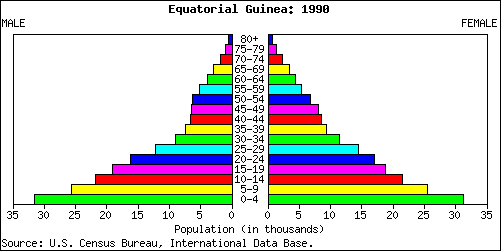
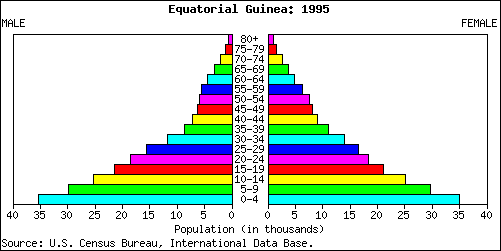
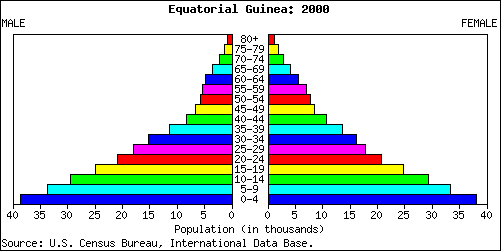
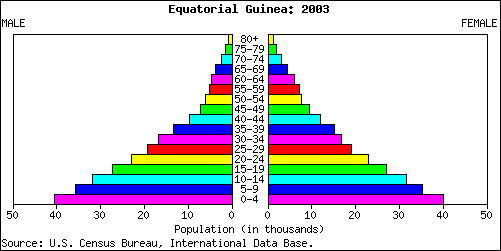
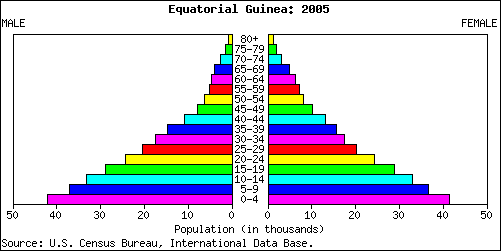
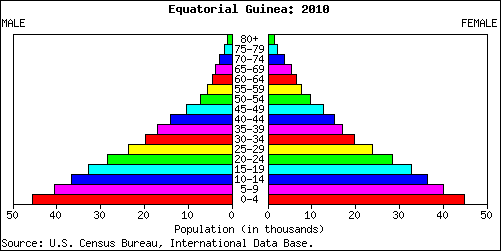
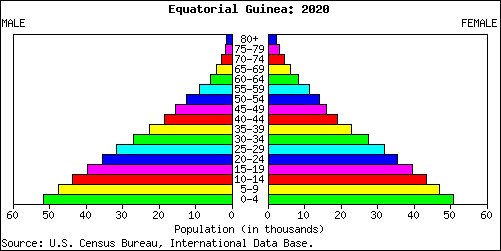
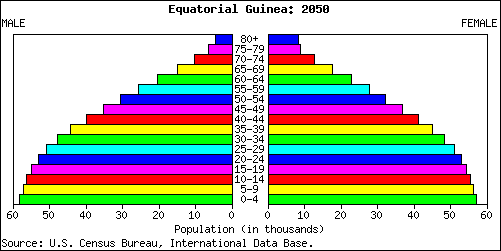
Labor
|
Economic activity > Both sexes aged 15-19 |
54.45 |
[37th of 167] |
|
Economic activity > Both sexes aged 20-24 |
69.72 |
[110th of 166] |
|
Economic activity > Both sexes aged 25-29 |
70.49 |
[147th of 167] |
|
Economic activity > Both sexes aged 55-59 |
72.68 |
[51st of 166] |
|
Economic activity > Men aged 20-24 |
94.75 |
[2nd of 166] |
|
Economic activity > Men aged 30-34 |
96.56 |
[123rd of 165] |
|
Economic activity > Men aged 65 plus |
49.65 |
[58th of 162] |
|
Economic activity > Women aged 20-24 |
45.02 |
[144th of 166] |
|
Economic activity > Women aged 65 plus |
20.79 |
[56th of 167] |
|
Female economic activity |
45.7% |
[106th of 156] |
|
Female economic activity growth |
1% |
[97th of 156] |
|
Firing cost > weeks of wages |
132.9 weeks of wages |
[10th of 164] |
|
force participation rate, female > % of female population ages 15-64 |
52.21 % |
[124th of 184] |
|
force participation rate, total > % of total population ages 15-64 |
72.59 % |
[63rd of 184] |
|
force, female > % of total labor force |
36.82 % |
[142nd of 184] |
|
force, total |
196,849.1 |
[161st of 184] |
|
Parental leave > Paid maternity leave |
12 weeks |
|
|
Right to Organise and Collective Bargaining Convention > Ratifications > Date |
August 13, 2001 |
|
|
Rigidity of employment index |
66 |
[10th of 166] |
|
Workers' remittances and compensation of employees, received > US$ |
1,000,000 $ |
[117th of 156] |
SOURCES Economic
activity rate and economically active population, by sex, thirteen age groups,
1950-2010 (ILO estimates and projections) are data from the International Labour
Union (ILO). Source details; ILO, Economically Active Population, 1950-2010,
fourth edition, diskette database (Geneva, 1997). The latest set of estimates
and projections covering the period 1950-2010 (4th edition) was released by ILO
in December 1996. These data are updated every five-ten years by ILO and a new
set of these data is in preparation; calculated on the basis of data on the
economically active population and total population from ILO (International
Labour Organization). 2002. Estimates and Projections of the Economically Active
Population, 1950-2010, 4th ed., rev. 2. Database. Geneva; World Development
Indicators database
; Wikipedia:
Parental leave ; Wikipedia;
Right to Organise and Collective Bargaining Convention, 1949
ALTERNATIVE NAMES Equatorial
Guinea, Republic of Equatorial Guinea, Republica de Guinea Ecuatorial, Guinea
Ecuatorial
People
|
Age dependency ratio > dependents to working-age population |
0.94 |
[14th of 185] |
|
Age structure > 0-14 years |
41.7 |
[46th of 226] |
|
Age structure > 15-64 years |
54.5 |
[188th of 226] |
|
Gender development |
0.669 |
[90th of 141] |
|
Percentage living in rural areas. |
52% |
[75th of 193] |
|
Percentage living in urban areas |
48% |
[124th of 199] |
|
Population > CIA Factbook |
616,459 |
[164th of 240] |
|
Population ages 0-14 > % of total |
44.39 % |
[17th of 185] |
|
Rural population |
307,650.1 |
[151st of 193] |
|
Sex ratio > 15-64 years |
0.93 |
[207th of 223] |
|
Sex ratio > sex ratios > total |
0.96 |
[151st of 215] |
|
Total Population |
540,109 |
[165th of 227] |
|
Total Population > Female |
276,226 |
[164th of 227] |
|
Total Population > Male |
263,883 |
[165th of 227] |
|
Urban population |
195,868.9 |
[167th of 195] |
|
Urban population growth > annual % |
2.32 annual % |
[85th of 195] |
|
Urbanization |
49 |
[125th of 204] |
|
Urbanization in 2015 |
61.4% |
[86th of 164] |
|
Women > Adult literacy rate females as a % of males |
80 |
[98th of 144] |
|
Women > Life expectancy females as a % of males |
104 |
[140th of 173] |
SOURCES World
Development Indicators database
;
CIA World Factbook
,
28 July 2005; Human Development Reports, United Nations 2002; Population
Division of the United Nations Secretariat, World Urbanization Prospects The
2003 Revision, Data Tables and Highlights. Estimates and projections of urban
and rural populations are made by the Population Division of the United Nations
Secretariat and published every two years. These estimates and projections are
based on national census or survey data that have been evaluated and, whenever
necessary, adjusted for deficiencies and inconsistencies; All CIA World
Factbooks 18 December 2003 to 18 December 2008;
U.S. Census Bureau,
Population Division, International Programs Center Spanish Statistical Institute
; Population
Division of the United Nations Secretariat, World Urbanization Prospects The
2001 Revision, Data Tables and Highlights (ESA/P/WP.173, 20 March 2002); UN
(United Nations). 2002. World Urbanization Prospects The 2001 Revision.
Department of Economic and Social Affairs, Population Division. New York; UNICEF
ALTERNATIVE NAMES
Equatorial Guinea,
Republic of Equatorial Guinea, Republica de Guinea Ecuatorial, Guinea Ecuatorial
Mortality
|
Death rate, crude > per 1,000 people |
20.55 per 1,000 people |
[10th of 195] |
|
rate, adult, female > per 1,000 female adults |
576.17 per 1,000 female adults |
[11th of 185] |
|
rate, adult, male > per 1,000 male adults |
571.87 per 1,000 male adults |
[11th of 185] |
|
rate, infant > per 1,000 live births |
123 per 1,000 live births |
[9th of 187] |
|
rate, under-5 > per 1,000 |
205 per 1,000 |
[8th of 187] |
SOURCES World Development
Indicators database
ALTERNATIVE NAMES Equatorial Guinea, Republic of Equatorial
Guinea, Republica de Guinea Ecuatorial, Guinea Ecuatorial
Immigration
|
immigrant population > Immigrants as percentage of state population |
1.19 |
[144th of 195] |
|
immigrant population > Number of immigrants |
6,000 |
[175th of 195] |
|
immigrant population > Percentage of total number of immigrants in the world |
>0.01% |
|
|
Net migration rate |
0 migrant(s)/1,000 populati |
[87th of 225] |
|
Refugees > Convention on refugees |
7 Feb 1986 a |
|
|
Refugees > Outflow |
1,000 |
[70th of 76] |
|
US visa lottery winners |
1 US visa lottery winners |
[165th of 178] |
SOURCES Wikipedia;
List of countries by immigrant population
; All
CIA World
Factbooks
18 December 2003 to 18 December 2008; United Nations Treaty
Collection; UNHCR (United Nations High Commissioner for Refugees). 2002.
Correspondence on refugees and internally displaced persons. February. Geneva.;
US Department of State; Bureau of Consular Affairs
ALTERNATIVE NAMES Equatorial Guinea, Republic of Equatorial
Guinea, Republica de Guinea Ecuatorial, Guinea Ecuatorial
| Other articles in this category |
|---|
| Equatorial Guinea at a glance |
| Geography |
| History |
| Culture |
| Economy |
| Politics |
| Military |